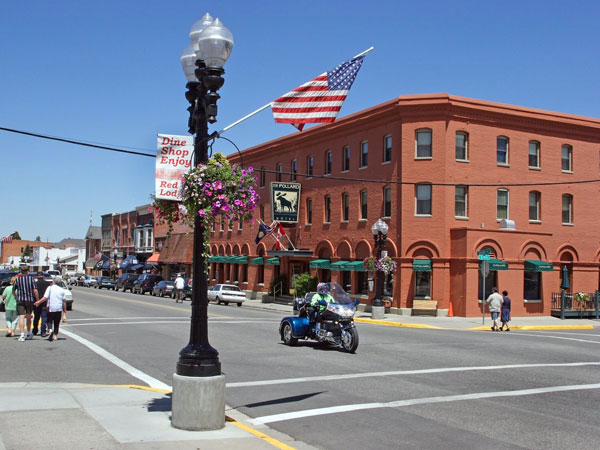Broadway Avenue: Red Lodge, Montana

Summary
Broadway Avenue juxtaposes downtown Red Lodge and its late 19th century Western vernacular buildings against a backdrop of rugged mountain wilderness. There are no traffic lights, and local drivers yield to pedestrians.

Broadway Avenue's original Western-vernacular architecture reflects European features, a reminder of Red Lodge's heyday as a coal mining town and the immigrants who shaped the community. Photo courtesy of Merv Coleman.
Planning Excellence
Many of the storefronts and other buildings lining the street's sidewalks reflect European influences, a reminder of the immigrants who came during the town's heyday as a major coal mining center in the late 1800s. Most of the structures have been restored and are now being adaptively reused as museums, restaurants, visitor centers, and local craft shops.
The other major influence contributing to Broadway's sense of place is its proximity and connectivity to the neighboring wilderness. Nestled high in a glacial valley near the base of the Beartooth Mountains, Broadway is the gateway to the Beartooth Highway — the northern access route to Yellowstone National Park and "the most beautiful road in America," according to the late "On the Road" correspondent Charles Kuralt.
For those not traveling by automobile, Broadway Avenue is part of the "Mainstreet to Mountains Rocky Fork Trail." This 80-mile network provides hikers, bikers, and cross-country skiers direct access from downtown to the neighboring scenery and wildlife. Not that one needs to leave downtown to see a wandering bear or moose on the street from time to time, another reminder of Broadway's intimacy with its wilderness surroundings.

Broadway Avenue's 'Old West' character is revealed through its most famous landmark – the Pollard Hotel. Still in use today, the brick structure has housed some of western America's most iconic figures such as Buffalo Bill and Calamity Jane. Photo courtesy of Merv Coleman.
Defining Characteristics, Features
Historic Heritage
- Red Lodge Commercial Historic District added to the National Register in 1983; expanded in 1986 to include all of Broadway Avenue between 8th and 15th streets
- Pollard Hotel, 2 N. Broadway St. (1893), town's first brick building; still operating, guests include William "Buffalo Bill" Cody and Martha "Calamity Jane" Cannary; Sundance Kid attempted bank robbery across street (1897)
- Carbon County Historical Society and Museum (224 N. Broadway Ave.) showcases town's history; three-story brick structure originally built in 1909 as the Red Lodge Miners Local No. 77 labor temple; served nearly 1,000 miners
Historic Preservation, Restoration Efforts
- Restoration efforts begin in 1983 with Patricia Bick of Montana State Historic Preservation Office; conducted a detailed study of each facade along avenue and laid the groundwork for 1986 Commercial Historic District Revitalization Plan
- Town participates in Montana Main Street program (2006); prompts local volunteers, community leaders to restore and promote Broadway Avenue, including site for annual Red Lodge Home of Champions Rodeo Parade each July
- Commercial Historic District Overlay adopted in 2006; protects downtown historic area through detailed design review; Carbon County Historic Preservation Officer approves any new construction or alteration to existing structures
- Red Lodge Development Code (2006) permits reuse of upper floors along Broadway Avenue for residential use
- No minimum parking requirements for businesses along avenue; outlined in 2008 Red Lodge Growth Policy in order to encourage infill development
- Street lights changed from "cobra head" style used along highways to 19th century–style lamp posts with hanging flower baskets in 2005
- Maximum building height of 45 feet and maximum setback of one foot help maintain uniform scale in keeping with Broadway's historic character
Connectivity
- Red Lodge Comprehensive Trails Plan (2006) creates the Rocky Fork Main Street to Mountains Trail; connects old trail segments into 80-mile-long foot, bike, and cross-country ski path. Connects the avenue at corner of Broadway and 8th Street to Red Lodge Mountain ski resort and scenic surroundings
- Broadway Avenue doubles as U.S. 212, Yellowstone National Park's most scenic access road; highway affords views of Custer National Forest and Granite Peak, the highest point of the Northern Rockies

A gateway to Yellowstone National Park, Broadway Avenue fosters a strong sense of place from its proximity and connectivity to the picturesque landscape. The street also hosts several annual parades and festivals. Photo courtesy of Merv Coleman.


